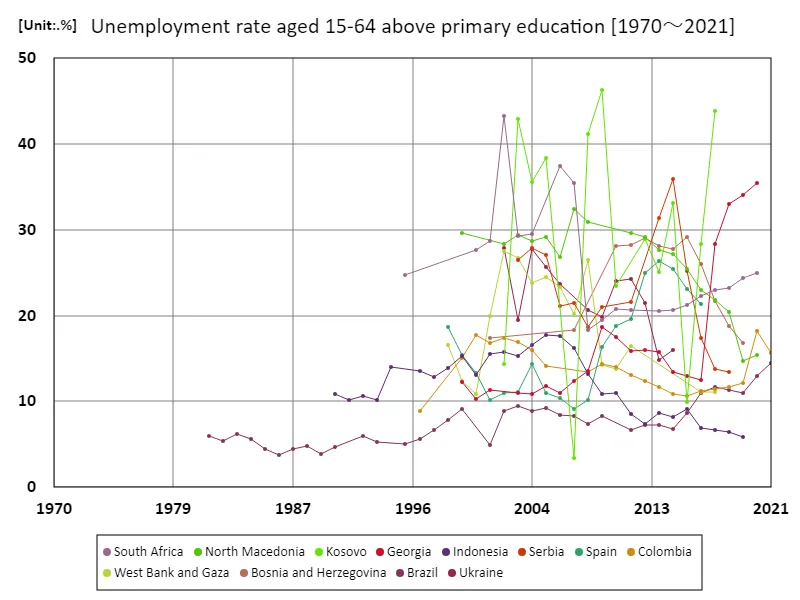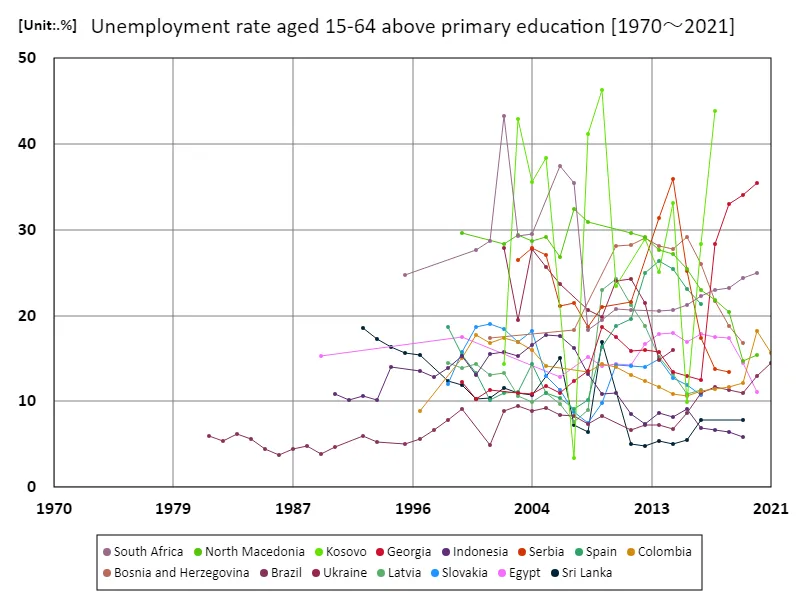- Abstract
- Unemployment rate for those aged 15-64 and with at least secondary education (percentage of working-age population with tertiary education)
- Unemployment rate for those aged 15-64 and with secondary education or higher (percentage of working-age population with tertiary education) (Worldwide)
- Unemployment rate for those aged 15-64 and with secondary or higher education (percentage of working-age population with tertiary education) (Worldwide, latest year)
- Reference
Abstract
In recent years, global unemployment rates have fluctuated due to various economic factors, including the impact of the COVID-19 pandemic. For individuals aged 15-64 with secondary education or higher, unemployment rates tend to be lower than the overall population, as higher education often correlates with better job prospects. However, countries like Colombia, with a high rate of 15.7% in 2021, face challenges such as economic instability, limited job creation, and disparities in access to education. Historically, regions with higher education access see a slower rise in unemployment but may still struggle with youth underemployment.
Unemployment rate for those aged 15-64 and with at least secondary education (percentage of working-age population with tertiary education)
The global unemployment rate for people aged 15-64 has shown significant variation since 1981, influenced by economic crises, technological shifts, and labor market dynamics. Kosovo’s peak rate of 46.3% in 2009 highlights severe unemployment challenges, often tied to political instability and limited economic opportunities. While Kosovo’s current unemployment rate is at 94.6% of its peak level, reflecting gradual recovery, global trends show that higher education correlates with lower unemployment. However, regions with high youth unemployment or limited education access still face persistent job market challenges.


The maximum is 46.3%[2009] of Kosovo, and the current value is about 94.6%
Unemployment rate for those aged 15-64 and with secondary education or higher (percentage of working-age population with tertiary education) (Worldwide)
The global unemployment rate for those aged 15-64 with secondary education or higher has been shaped by various economic and political factors since 1981. Kosovo’s peak unemployment rate of 46.3% in 2009 highlights the severe challenges faced by economies in transition, often driven by political instability and limited job creation. Currently, Kosovo’s unemployment rate is at 94.6% of its peak level, indicating some improvement. Worldwide, higher education generally leads to lower unemployment, though youth unemployment and underemployment remain persistent challenges in many regions.


The maximum is 46.3%[2009] of Kosovo, and the current value is about 94.6%
Unemployment rate for those aged 15-64 and with secondary or higher education (percentage of working-age population with tertiary education) (Worldwide, latest year)
In 2021, Rwanda’s unemployment rate for those aged 15-64 with secondary education or higher reached 24.6%, significantly higher than the global average of 10.1%. This reflects challenges in transitioning to higher-skilled employment despite rising educational attainment. Globally, countries with higher unemployment rates often face economic constraints, such as limited job creation, underdeveloped sectors, or high youth unemployment. While educational levels are generally linked to lower unemployment, disparities in access and economic conditions can still lead to significant job market challenges, particularly in developing nations.


The maximum is 24.6% of Rwanda, the average is 10.1%, and the total is 162%



Comments